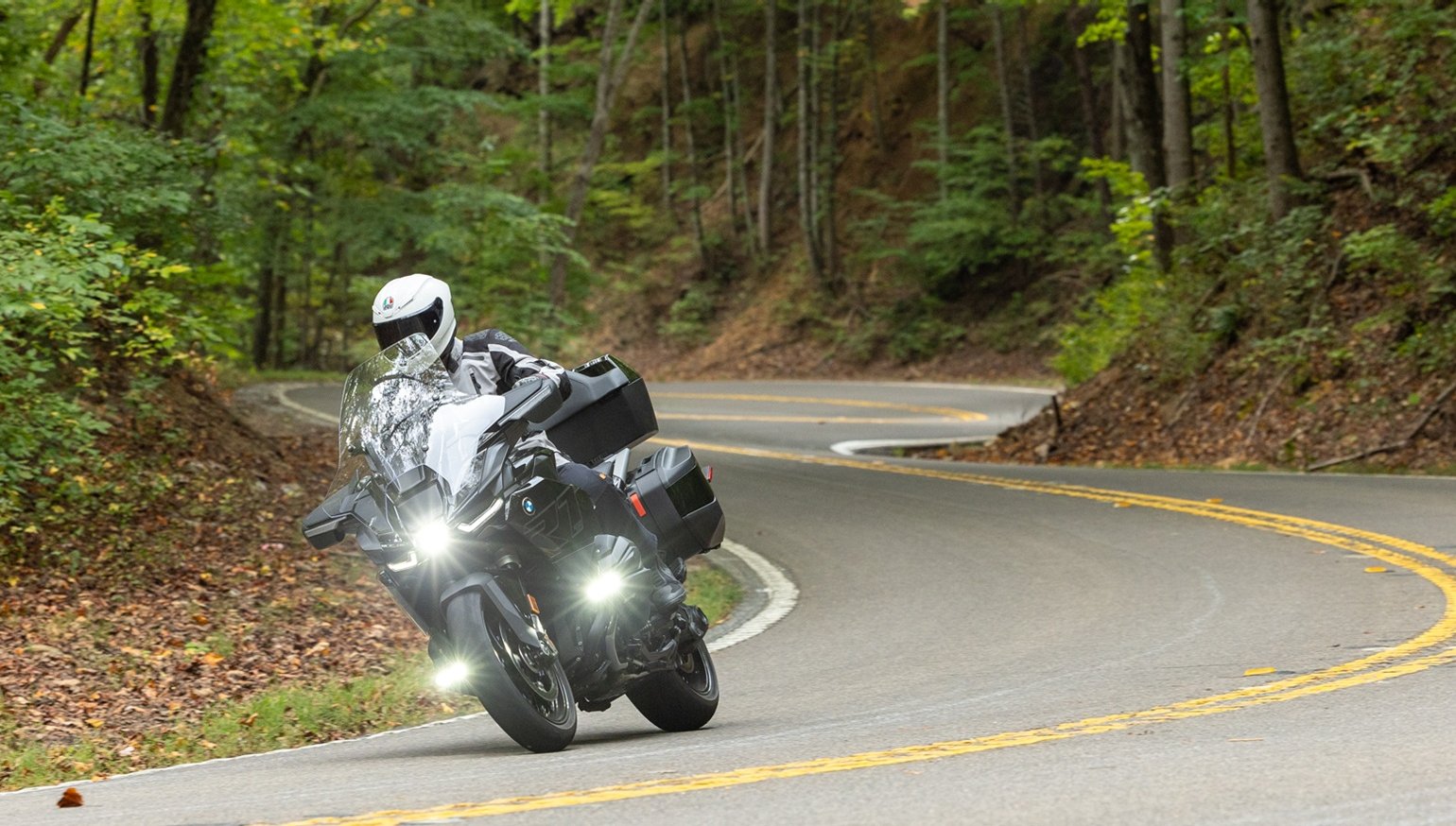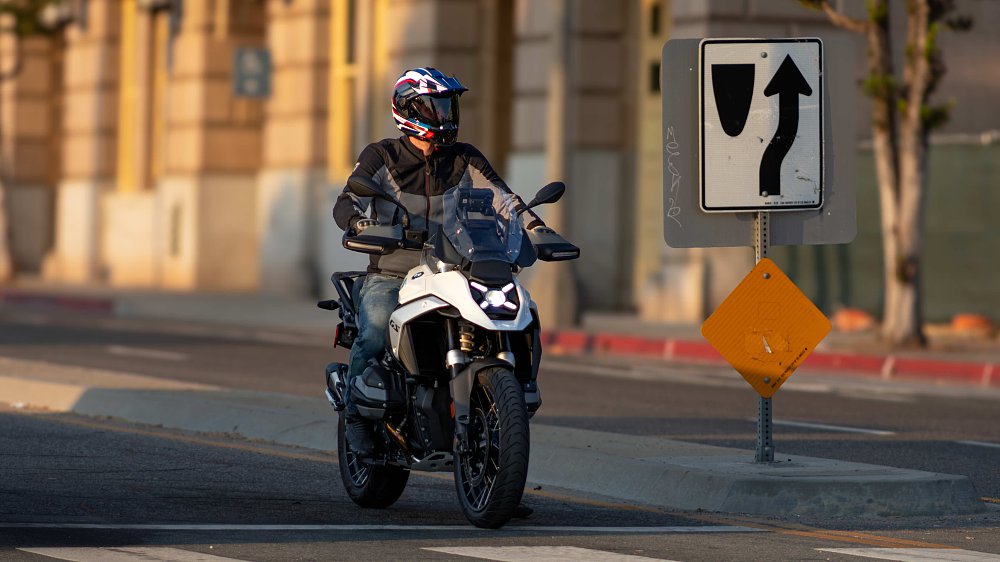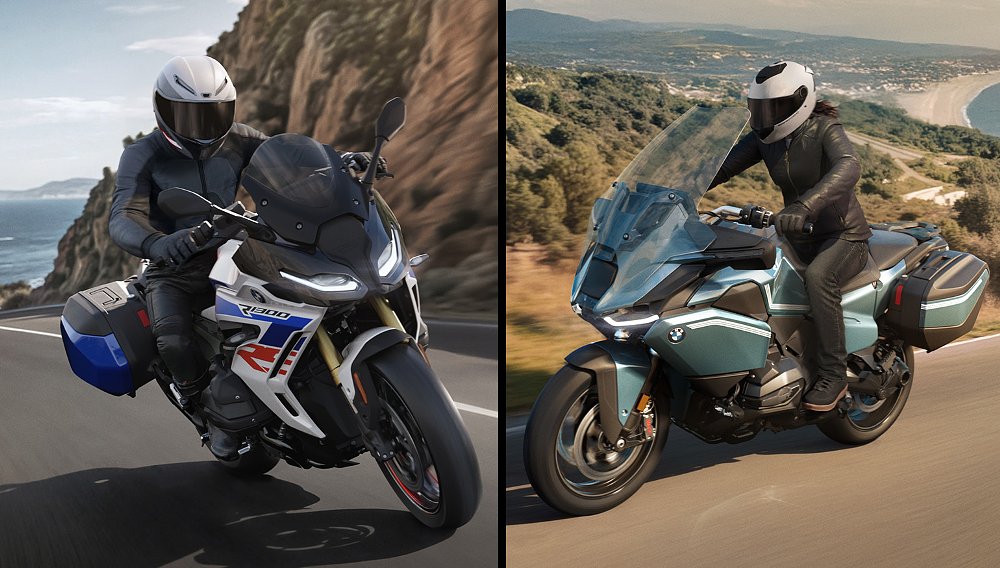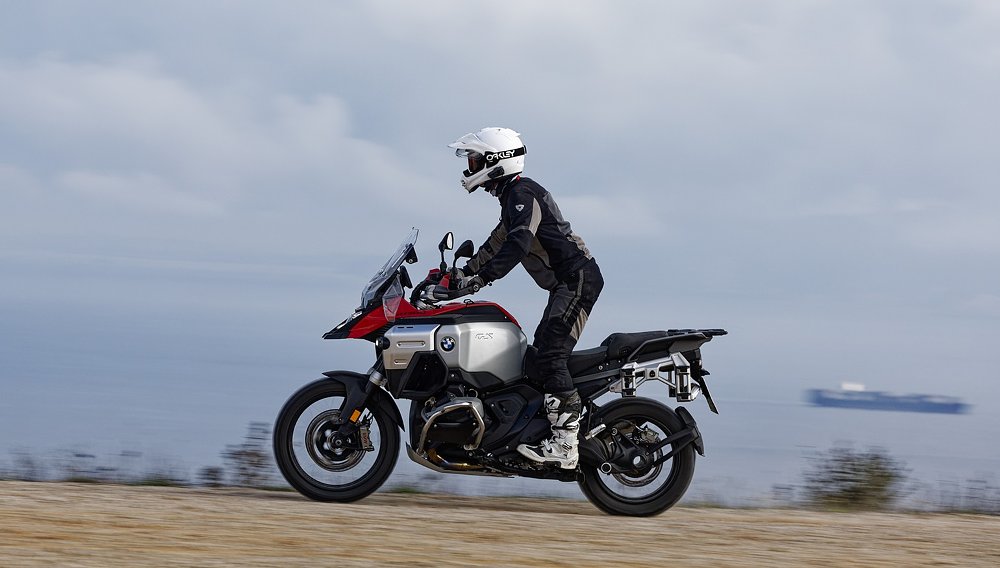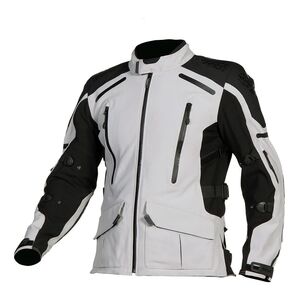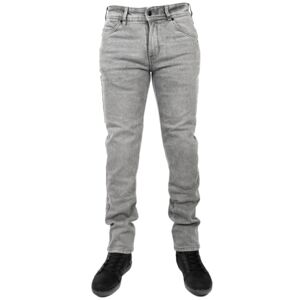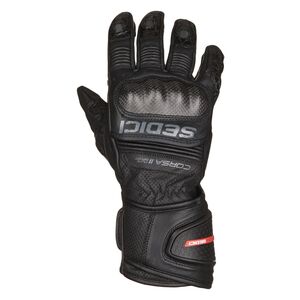After a few days riding the 2026 BMW R 1300 RT, I found myself searching for an example of a feature found on a motorcycle today that wasn't on BMW's touring boxer. It wasn't easy.
This motorcycle will shift gears without any input from me, if I want. It adjusts the suspension settings for me based on the ride mode I've chosen. In cruise control, it will slow down for me if I creep too close to the car ahead. If it thinks I'm in danger of hitting something, it will warn me and add some braking force, and if I do crash, it can call emergency services for me. It monitors my tire pressure and locks the fuel filler cap for me after I stop and turn off the power. A dozen LEDs in the headlight sense my lean angle and illuminate the corner at night. Not only will you have heated grips and a heated seat, but tick the right boxes on the options sheet and your passenger will have a heated seat. And heated grab handles. And a heated backrest. And there's a lot more. The owner's manual is 330 pages long.
But eventually I did find one feature available on a few other motorcycles that the BMW does not offer: a reverse gear.
That's it. That's all I could think of.
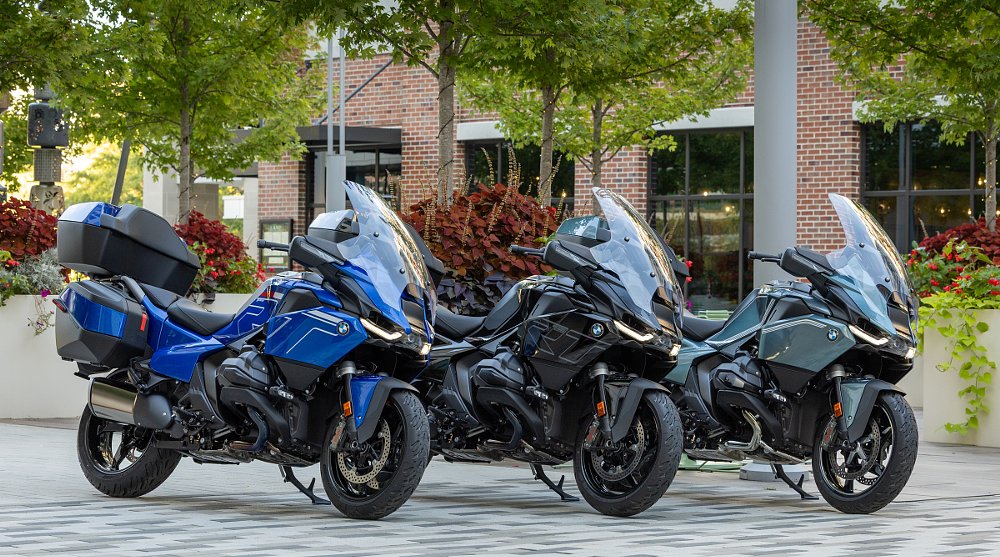
If your idea of motorcycling bliss is an elemental experience, just you and the minimum of two wheels and an engine needed to get down the road with you fully in control, and your typical ride is a 25-mile round trip to get ice cream, then the R 1300 RT might be the most unsuitable motorcycle for you that I've ever ridden. But if you're the kind of rider who wants all the technology, all the features, nothing that even resembles a sacrifice, and especially if you plan to cover lots of miles, this is the ultimate in the RT line that has made its reputation on combining capability and comfort.
The RT gets the 1300 treatment
As the name indicates, the RT now gets the 1,300 cc air-and-liquid-cooled opposed-twin engine that has been filtering into BMW's R line, starting with the 2024 R 1300 GS. Rated at 145 horsepower, the boxer twin uses BMW's ShiftCam technology to provide variable valve timing on the intake side for better power across the rpm range. BMW recommends 89 AKI fuel (95 ROZ/RON, for those outside the United States).
Like the other R 1300 models, the RT gets the new sheet-metal frame and aluminum sub-frame. BMW continues to evolve its Telelever front and Paralever rear suspension designs. The RT also gets the "flex element" in the front Telelever suspension that is designed to allow steering forces to be transmitted to the handgrips while preventing the tilting movement that is inherent in the suspension design and caused what some riders felt was unnatural feedback.
BMW says the ergonomics have been tweaked to make the RT a smidge more sporty, basically by moving the hand grips a little forward. It's still definitely a riding position that's at the touring end of the sport-touring spectrum.
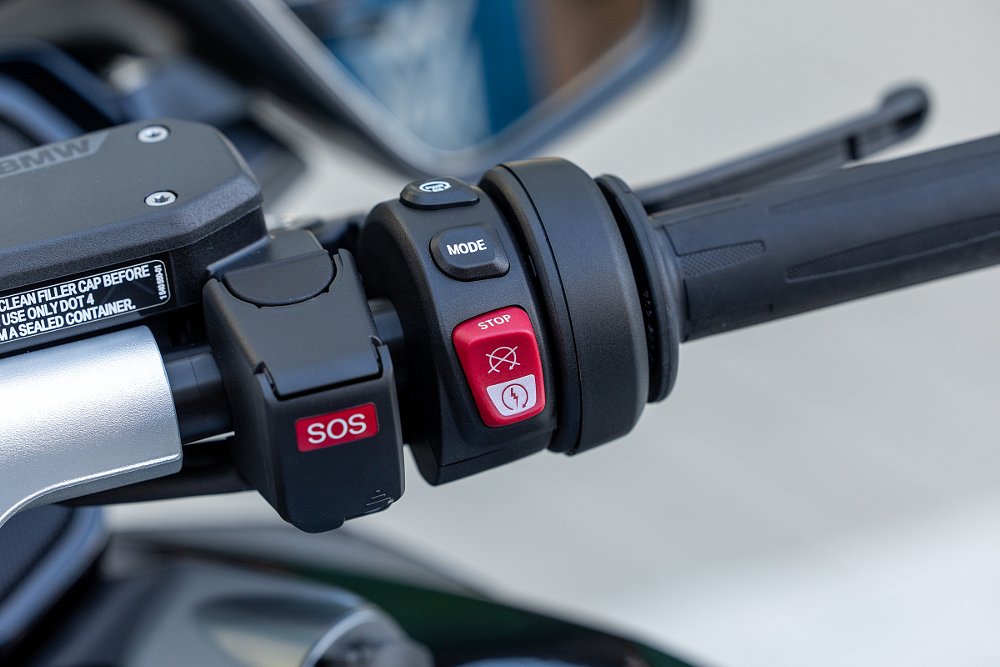
Standard features include the radar-informed Active Cruise Control, Frontal Collision Warning, and Lane Change Warning. That means the cruise control will automatically slow down or speed up the motorcycle to maintain the desired distance between you and the vehicle ahead. Forward Collision Warning will not only flash a warning if you're closing too fast on something ahead but will also apply braking force, if needed. And Lane Change Warning means you have those little yellow triangles on the mirrors alerting you to vehicles in your proximity.
Yes, the RT comes with a long list of standard features, but the optional packages, in common BMW fashion, substantially increase the complexity. Buying one of BMW's top models means making a lot of decisions. Finding a stripped-down version may be impossible, though the BMW folks tell me you can order exactly what you want, as long as you're willing to wait for it to be built. With so many combinations of options available, what you find on your local dealer's floor may not be exactly the combination of options you want.
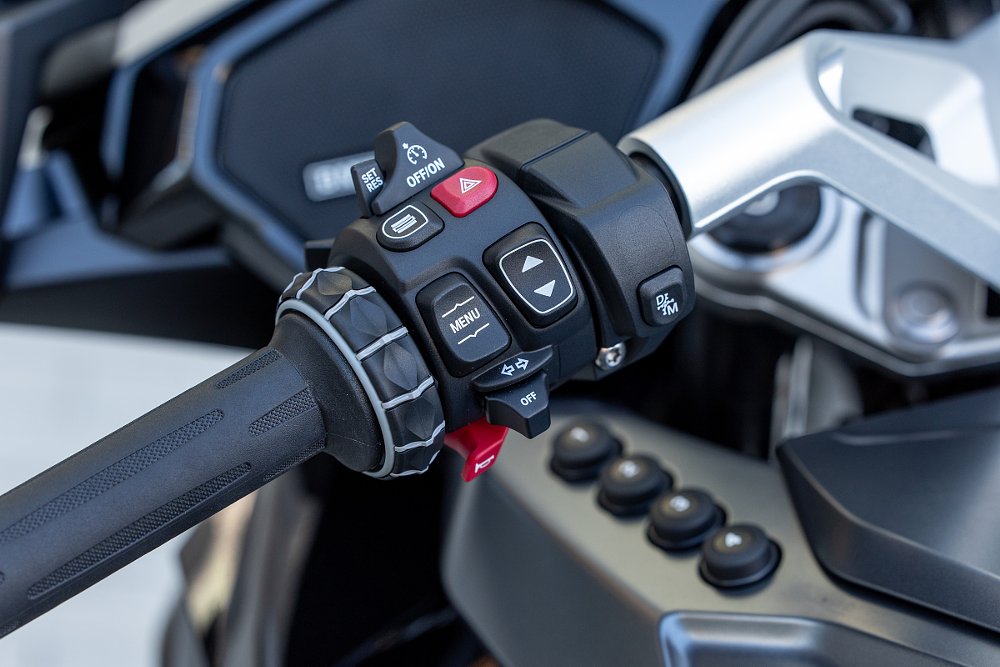
Not surprisingly, the units BMW had for us to test were loaded with options. So we had not just the three standard ride modes of Eco, Rain, and Road, but also the optional Dynamic and Dynamic Pro modes. Those ride modes adjust not just traction control settings, but also suspension settings. Dynamic Suspension Adjustment (DSA) electronically changes suspension settings and optional Dynamic Chassis Adjustment (DCA) goes a step further and alters the RT's chassis geometry. These are tied to the ride modes, so if you switch from Road to Dynamic Pro, for example, you'll not only get firmer suspension settings, but the rear ride height will be raised by 0.86 inches, effectively creating a steeper steering angle for sharper handling. In a related trick, called Prop-Up Aid, if you begin to deploy the center stand (which is an option), the suspension will raise the rear height to make it easier to get the bike up on the stand.
Perhaps the biggest option on the list is the Automatic Shift Assistant (ASA). You can get an R 1300 RT with a regular transmission and a clutch lever, but the ASA eliminates the manual clutch entirely and allows you to shift gears yourself or have the motorcycle do it for you. I'll have a lot more to say about ASA in the riding impressions section below.
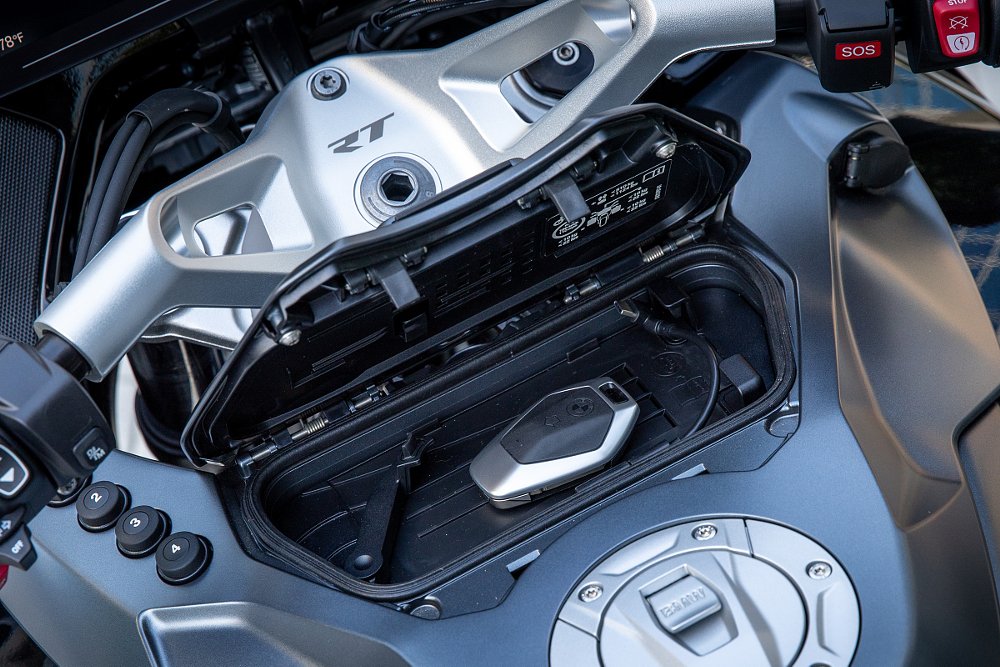
That's just the beginning of the options you can choose from, but those are probably the most important ones. The test units we rode were also outfitted with the Comfort Passenger Package, with heated seat, grab handles, and backrest, plus the expandable Vario side cases. The RT comes with a lot of nice touches, such as a light and power supply in the 54-liter top case, another power outlet in the left side case, and a small compartment on top of the fuel tank that not only holds your phone securely and keeps it charged, but also keeps it cool with a small fan that provides active ventilation.
It's a lot to consider and a lot to evaluate. Fortunately, BMW gave me lots of time and miles with the R 1300 RT to explore its performance.
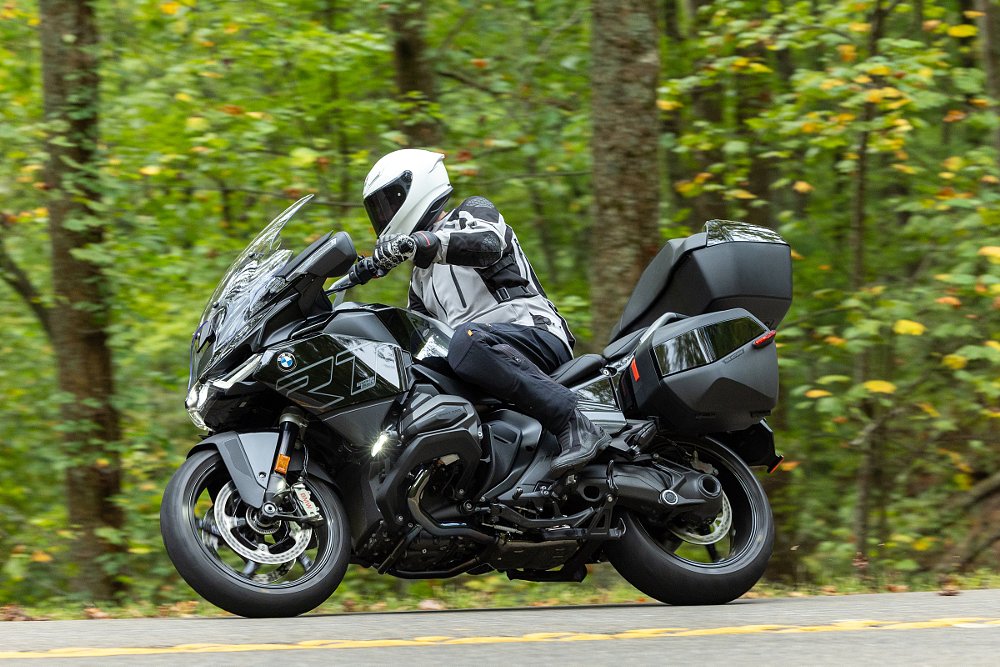
Riding the BMW R 1300 RT
So far, I've put 1,848 miles on the R 1300 RT and I still have to return it to BMW headquarters in New Jersey. My time with the RT started with a two-day group ride from Greenville, S.C., to Barber Motorsports Park in Leeds, Alabama, which included some of the popular roads in that part of the country, such as Georgia Highway 60 and Little River Canyon in Alabama. Then, after a day enjoying the sights at the Barber Vintage Festival, I rode the RT home to Massachusetts and rode it around locally. The ride north was mostly Interstate highway miles that gave me ample opportunity to test the cruise control, but I also detoured to ride the Cherohala Skyway, so I could cross that road off my bucket list.
I definitely feel the weight of the RT when hefting it off the sidestand to get underway or, even more so, moving it around the garage. BMW lists the wet weight as 619.5 pounds, but that's before the top box and the other options on my test unit, and while the boxer engine keeps a lot of the weight low, the 6.3-gallon tank has a generous load of fuel up high. This is a motorcycle I make sure never to park in a position that is going to force me to back it up unless gravity is on my side. I also feel the weight when putting it on the center stand, despite the RT's party trick of raising the rear of the bike when you start to deploy the stand. Clever, but it still didn't pop up on the stand until I put my full 175-pound weight on it.
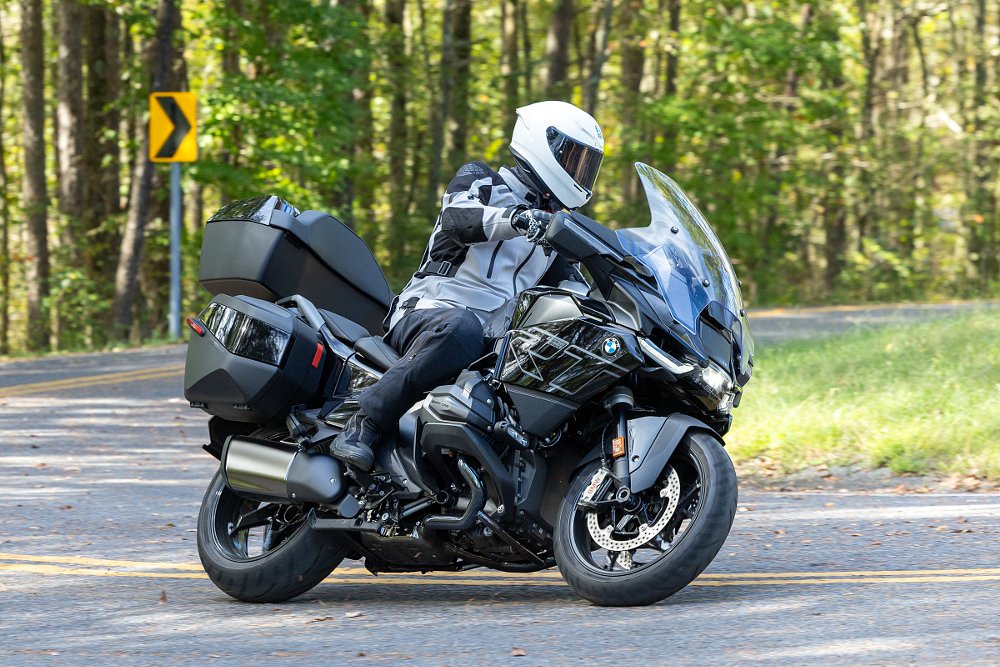
I know it's an overused cliché, but it's true: The weight disappears once you get rolling. On our ride to Barber, we hit lots of curvy roads and I kept the ride mode set in Dynamic Pro, which firms up the suspension settings and adds the bit of rear height mentioned above. You can also go into the menu on the TFT display and add or subtract damping from the suspension settings to fine tune the feel further. The RT is no flickable sport bike, but it handles commensurate with its status: stable, predictable, neutral, and overall competent.
As someone who doesn't ride BMWs with the Telelever front suspension regularly, nothing about the feedback felt unusual to me. The lack of brake dive is actually a negative to some people, just because they're used to it. But the weight transfer under braking into corners felt "normal" to me and I was never left thinking I didn't have a feel for what the front contact patch was doing.
Meanwhile, when it came time to power out of those corners, I was impressed at what a 1,300 cc two-cylinder engine can do. The ShiftCam variable valve timing does its job and provides a wide power band. The torque peaks at 6,500 rpm but even if you're dipping a little below 5,000 rpm, the engine pulls you out of the corner with a smooth shove in the back. Meanwhile, later in my trip home when I was out on the Interstate and burning up miles, the RT just loped along. Sixth gear at 4,000 rpm yields an indicated 80 mph. I averaged about 43 miles per gallon in mixed riding, which means the 6.3-gallon tank easily surpasses the 200-mile mark in range that many touring riders demand.
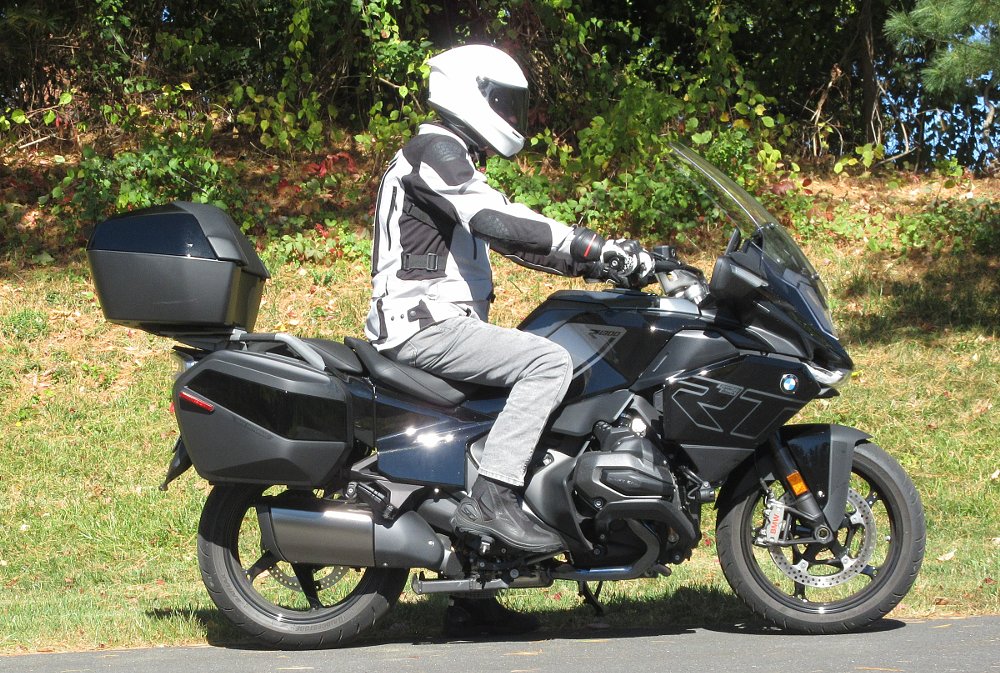
The brakes are linked, so after I tried the foot brake pedal once to confirm that it worked, I just used the lever for all braking duties the rest of the time I rode the RT. Feel and power were appropriate for a touring bike and I had no complaints. Twice I experienced the Frontal Collision Warning (FCW) system kicking in. Both times were during our group ride when we were on the curvy roads of northern Georgia. I wasn't really about to hit one of my fellow riders, but I made the RT's radar unit nervous. Entering tight curves at the end of straight sections, the rider in front of me was already slowed for the curve as I was just starting my braking. It wasn't the distance between us that triggered the FCW, but rather the increase in closing rate. Both times, the red warning symbol flashed on the display, the bike sent me a warning pulse through the brake lever, and it added a bit of braking force. In the end, it was an unnecessary intervention, but it didn't disrupt my corner entry.
When I was on the highway letting the Active Cruise Control do its thing, FCW was never triggered and the cruise control slowed me down smoothly on its own, then speeded back up when I moved over to a clear lane or otherwise had open space ahead. I didn't test FCW by intentionally trying to rear-end anyone. I know some people will be uncomfortable with the idea of the motorcycle deciding to apply the brakes unbidden, and my California colleagues report that it can be an issue when lane-splitting. In those cases, FCW can be turned off.
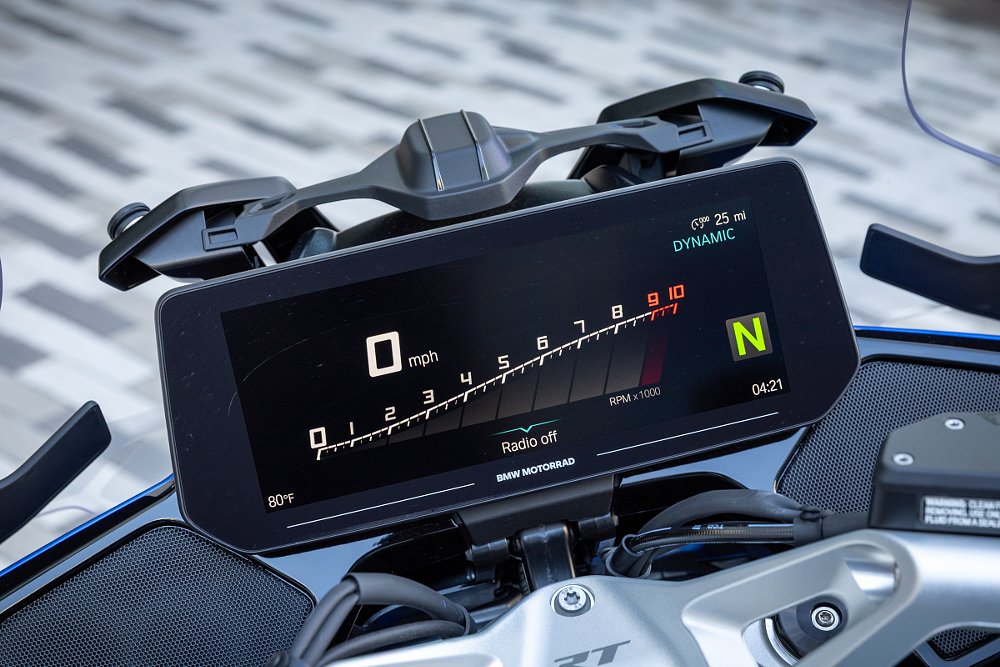
That brings us to the option I was most interested in testing, the Automatic Shift Assistant (ASA). ASA can shift gears for you, but it's not best described as an automatic transmission. Inside, it is a six-speed transmission and a multi-plate clutch just like on the R 1300 RT models without ASA that have a traditional clutch lever. ASA adds a mechanism that operates the clutch for you if you set the transmission to M, and you continue to shift gears with the foot lever, as usual. Or, if you set the transmission in D, ASA will both operate the clutch and shift up and down through the gears for you, based on engine and motorcycle speed, throttle, etc. You can switch between D and M using a dedicated button on the left switchgear pod and you can change back and forth while you're riding.
D mode, in my opinion, is best used when creeping through city traffic or cruising down an open highway. I was less satisfied with it in any kind of dynamic riding situation because the RT and I had a fundamental disagreement about what gear it should be in. When I was riding the bike in M mode on a curvy road, I would keep the engine spinning above 5,000 rpm, which provided a satisfying surge of thrust out of the corner. Any time I switched from M to D, the transmission would shift up at least one, sometimes two gears, which meant the engine was spinning around 3,000 rpm, or even as low as 2,500.
And that was when I was in the Dynamic Pro ride mode. In Road mode, the transmission tried to keep the engine speeds even lower. Riding around town one day after I got home, the RT was climbing a slight rise on a slow side street, the engine spinning just 2,000 rpm, but still the transmission did not want to downshift from third gear.
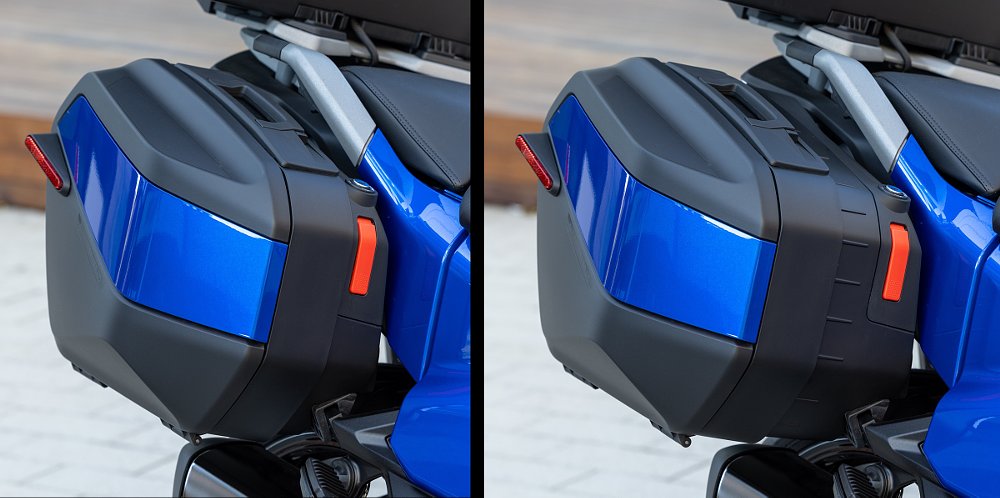
All this means, in my opinion, that D is fine for crawling through urban gridlock or when you're in cruise control on the open highway in "set it and forget it" mindset. If I used D while trying to make brisk progress on a curvy road, I inevitably entered corners with less engine braking than expected or desired and when I rolled on the throttle at corner exit the engine struggled to accelerate. The transmission was too reluctant to downshift to compensate. When in D, you can override the motorcycle's brain and downshift manually, but after about 20 seconds or so the transmission goes back to selecting the (too high, in my opinion) gear it prefers.
M, on the other hand, provides a delightful experience. You shift gears with the foot lever, just like you're used to, but the RT does all the clutch work for you. In practice, when you're moving, it's like having a really great bidirectional quickshifter that works at all engine speeds and in all gears. Don't try to blip the throttle or anything. Just hold the throttle steady and upshift or downshift and you'll instantly be in the selected gear more smoothly than you could do it yourself with a manual clutch. When the light turns red, your left hand remains at rest. Just downshift as normal and you'll come smoothly to a stop. If you need to creep forward, just add a touch of throttle. The RT handles it all shockingly well.
Another advantage of ASA is that you literally cannot stall the engine on this motorcycle. I know, because I tested that. At a few intersections, I stopped at the traffic light and left the transmission in fourth gear. The RT won't let you do something stupid like try to pull away from a stop in fourth gear. Even though I was in M, the transmission shifted down to at least second, and sometimes first gear, if I neglected my downshifting responsibilities.
At the end of our two-day group ride, a multi-car collision had two of the three westbound lanes on I-20 blocked. Traffic was barely crawling for a couple of miles until we cleared the accident scene. The same thing happened to me again on the ride home on I-81 in Pennsylvania: a five-mile backup due to a three-car pileup. On any motorcycle with a clutch, those tie-ups would have been a major workout for my left hand. On the R 1300 RT, I just eased along, between standstill and 10 mph, with no jerking or lurching or worries about stalling the engine.
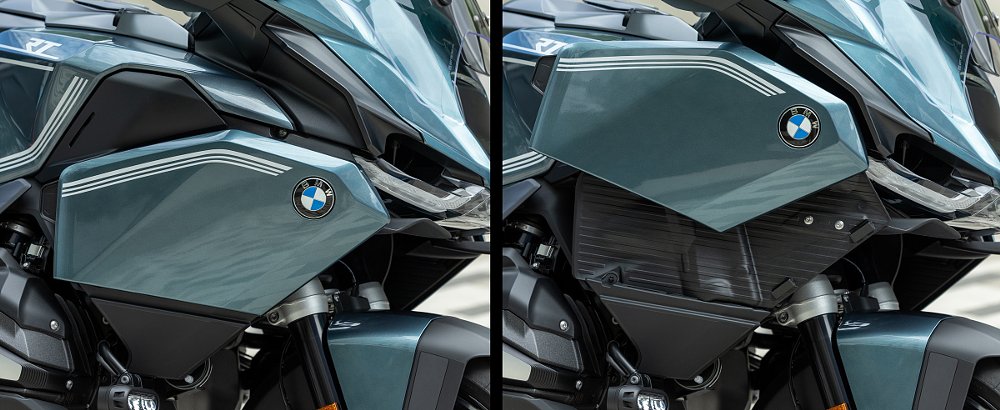
Speaking of highway riding, wind management is one area where BMW spent a lot of attention when redesigning the RT. Bodywork around the cylinders is intended to provide more weather protection for the rider's feet. Those two side panels can be manually slotted into an upper or lower position to adjust air flow. In the normal, lower position they allow more cooling air to hit the rider's lower body and waist area. Reach out and pull them up, which is not hard to do while riding, and they provide more wind deflection for when it turns cold or rainy. I found the difference to be small but noticeable. The adjustable windscreen has venting that is intended to prevent any backpressure on the rider, and I never felt any odd effects with the screen in any of its positions.
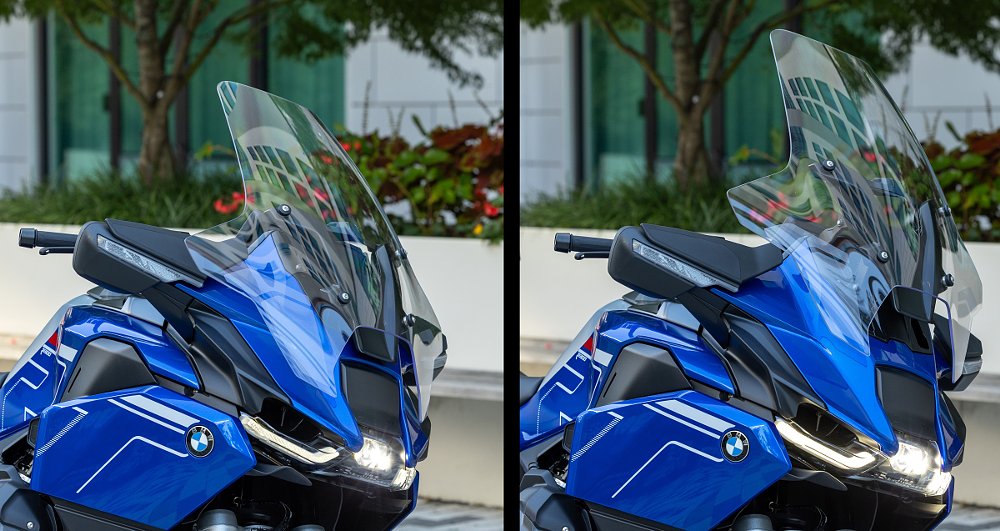
For my height, at five feet, 11 inches tall, the windscreen in the lowest position had the airstream hitting the top of my forehead, which created a little noise but no unusual buffeting. With the windscreen fully up, I was sitting in a totally still air pocket. The only thing quieter would have been switching to one of BMW's four-wheeled offerings. The top edge of the screen was right in my view, however. And another side effect of having the screen fully raised is that it makes the RT more susceptible to the effects of crosswinds or turbulence off the large trucks I was dodging for my 1,200-mile ride home. That effect was more noticeable when I was in Dynamic Pro ride mode with its sportier stance.
With smooth power, stable handling, good wind protection, generous range and luggage capacity, and an array of comfort features and rider aids helping me get down the highway, my only real complaint about the R 1300 RT, in terms of long-distance capability, is the seat. By general motorcycle standards, the R 1300 RT's seat is good. But by the lofty standards I set for a $30,000 touring motorcycle, I wished for more comfort, and a couple of other writers along on the ride said the same.
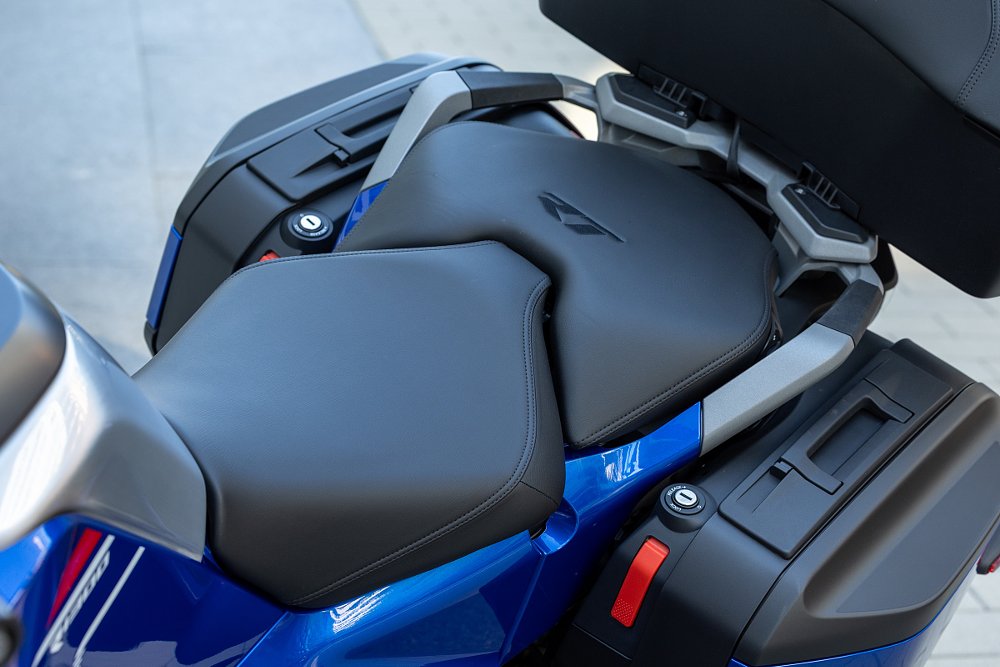
I suppose I should also provide some evaluation of the R 1300 RT's sound system but I'm equally inclined to disqualify myself because I just don't understand why anyone wants a couple of speakers in the fairing trying to overcome the blast of wind noise on the highway. If you love music, don't you want to hear it in good quality? Any pair of in-helmet speakers would provide greater fidelity at highway speeds. I did try the BMW's radio while it was parked in my garage one day, for background music while doing some other tasks. Even after using the equalizer to increase the bass to the max, it still sounded tinny to me. I didn't want to imagine what the music sounds like on the road. So ignore my opinions on motorcycle stereos. I clearly just don't get it.
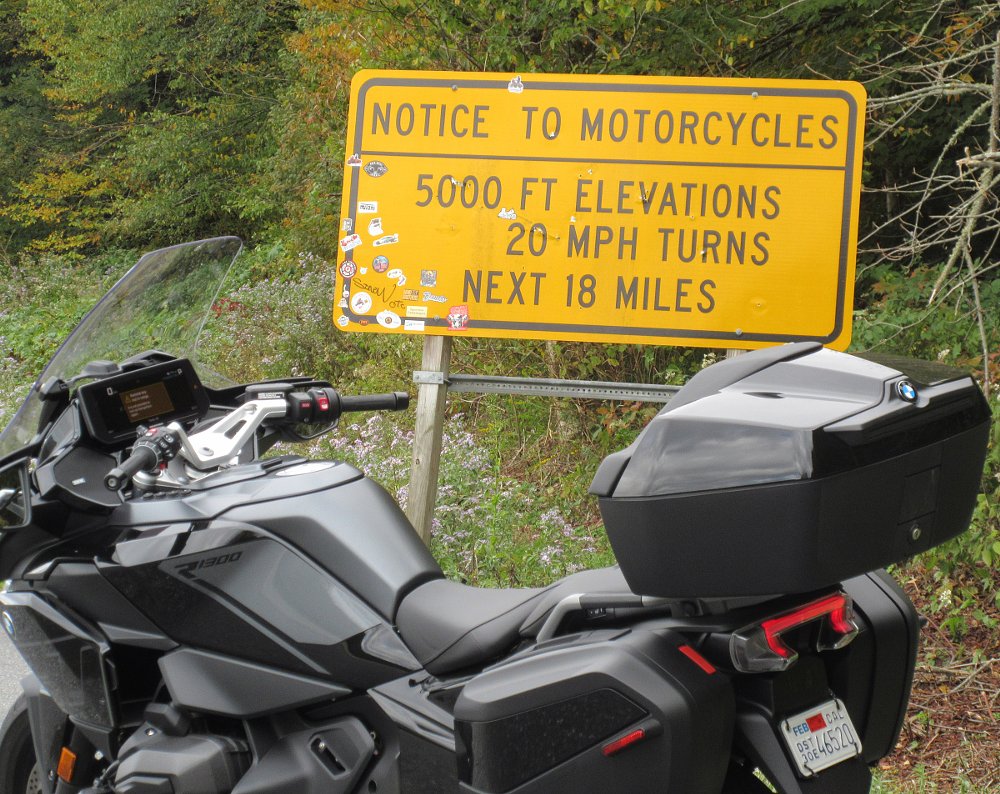
The R 1300 RT's place in the touring landscape
I'm no doubt guilty of recency bias, but I can't help but compare the R 1300 RT to the Honda Gold Wing, even though at first glance you might think those two motorcycles are more different than they really are. On paper, the obvious Gold Wing competitor in the BMW line is the six-cylinder K 1600, but the R 1300 RT is really in the same class, too. In the spring, I left Barber Motorsports Park for a two-day ride on the 50th Anniversary Gold Wing with the DCT transmission. In the fall I rode into Barber Motorsports Park after a two-day ride on the R 1300 RT with ASA. No clutch lever on either bike.
The Gold Wing weighs 200 pounds more but carries its weight low and both motorcycles handle so well that their weight is not apparent when you're flying down the road, but becomes very noticeable when you stop. On a purely subjective level, the two don't feel 200 pounds apart. Maybe it's like my colleague Dustin said when I was trying to describe the situation to him. "At some point," he said, "it's just heavy." True. What he meant is that once you reach a point where you have to be mindful of the weight and never put yourself in a position of having to muscle the motorcycle around, another hundred pounds, give or take, doesn't really matter.
BMW and Honda took different approaches to eliminating the clutch. Both work very well. If you're already driving a sporty car and shifting gears with paddles on the steering wheel, maybe you'll like Honda's setup that lets you shift gears with buttons on the left handgrip. But the BMW system will feel more familiar and natural from a motorcycle-centric perspective. You're still shifting gears with your left foot. You just don't have to worry about operating the clutch.
In the end, I preferred the way the Gold Wing's transmission worked when I was letting the motorcycle shift gears for me but I preferred the BMW when I was shifting gears. That was because the RT's automatic clutch resulted in such utterly smooth shifts and I have decades of muscle memory of shifting gears with my toe, not hitting a button with my thumb. Consider your own preferences and choose accordingly.
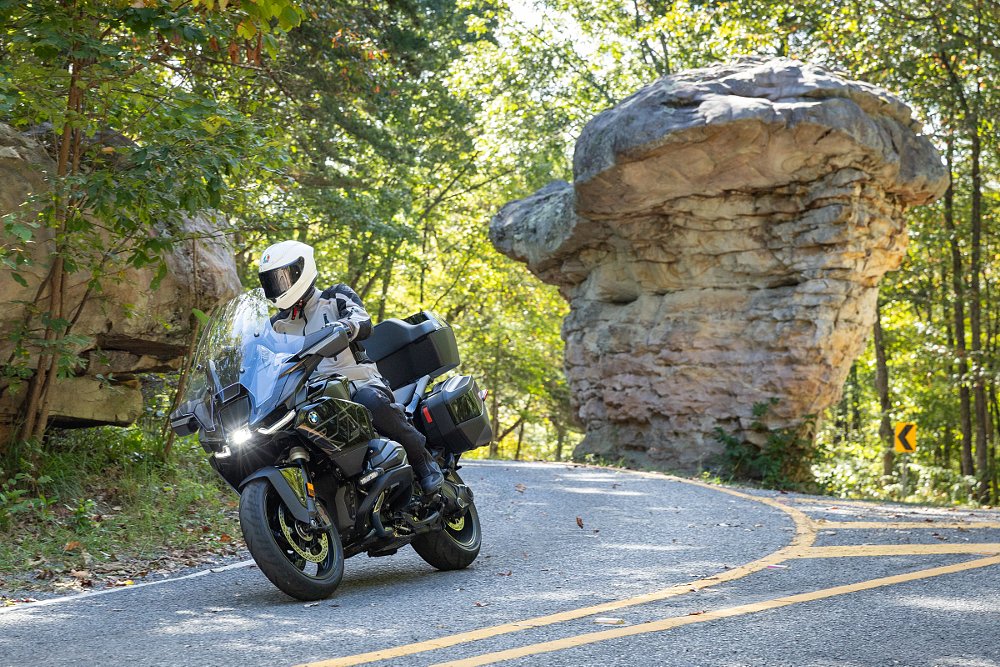
The RT checks all the boxes that some demanding riders require from a touring motorcycle: low-maintenance shaft drive, smooth and ample power, long fuel range, the ability to toast your fingertips or warm your backside or alter your wind protection with the flip of a button (and now you can adjust your lower body wind protection, too), and the capacity to carry a trip's worth of necessities. For 2026, the R 1300 RT also offers options for every electronic safety and convenience feature you'd expect to find. And while the RT is a little heavier than its ancestors, it still rewards with fun handling when you veer off the highway, as I did, to cross the Cherohala Skyway off your bucket list.
| 2026 BMW R 1300 RT | |
|---|---|
| Price (MSRP) | $22,499 base; $31,675 as tested |
| Engine | 1,300 cc, air-and-liquid-cooled, eight-valve, opposed twin |
|
Transmission, final drive |
Six-speed, shaft |
| Claimed horsepower | 145 @ 7,750 rpm |
| Claimed torque | 110 foot-pounds @ 6,500 rpm |
| Frame | Steel sheet |
| Front suspension | BMW Motorrad EVO Telelever; 5.9 inches of travel |
| Rear suspension | BMW Motorrad EVO Paralever, WAD shock; 6.2 inches of travel |
| Front brake | Dual four-piston radial-mount calipers, 310 mm discs, with ABS |
| Rear brake | Single one-piston caliper, 285 mm disc, with ABS |
| Rake, trail | 26 degrees, 4.5 inches |
| Wheelbase | 59 inches |
| Seat height | 30.7 to 33.9 inches |
| Fuel capacity | 6.3 gallons |
| Tires |
Bridgestone Battlax T32* 120/70ZR17 front, 190/55ZR17 rear (* as tested; some have Michelin Road 6) |
| Claimed weight | 619.5 pounds wet |
| Available | Now |
| Warranty | 36 months |
| More info | bmwmotorcycles.com |




